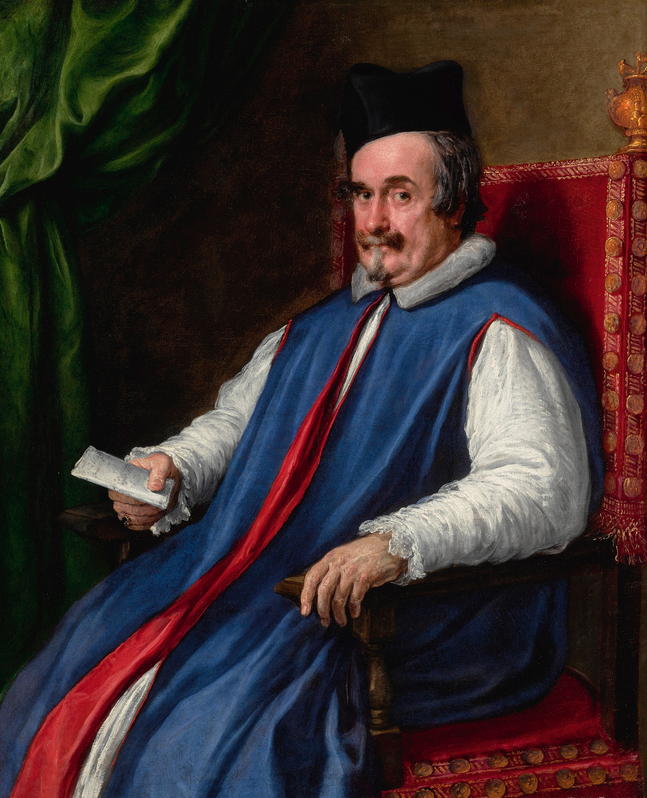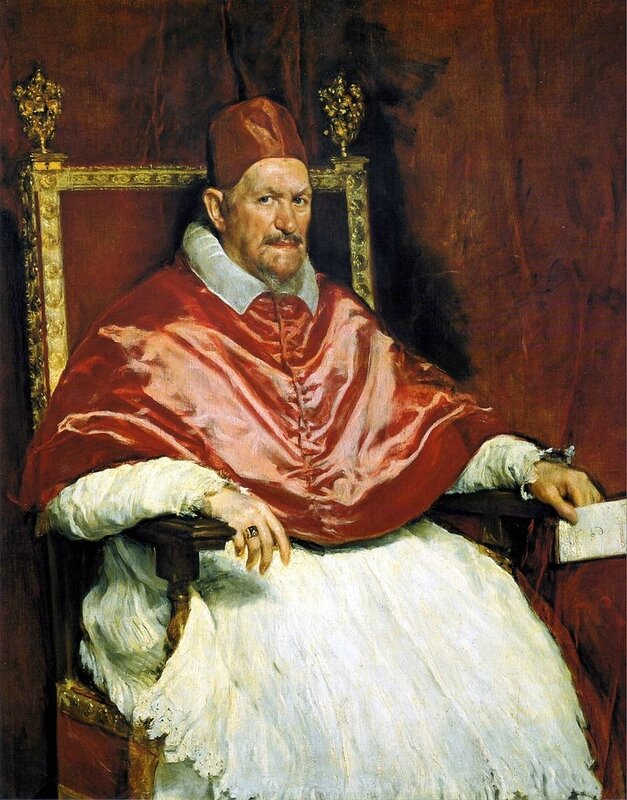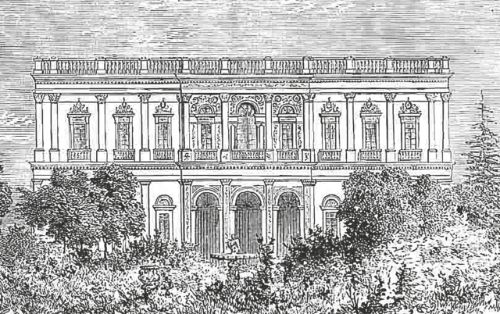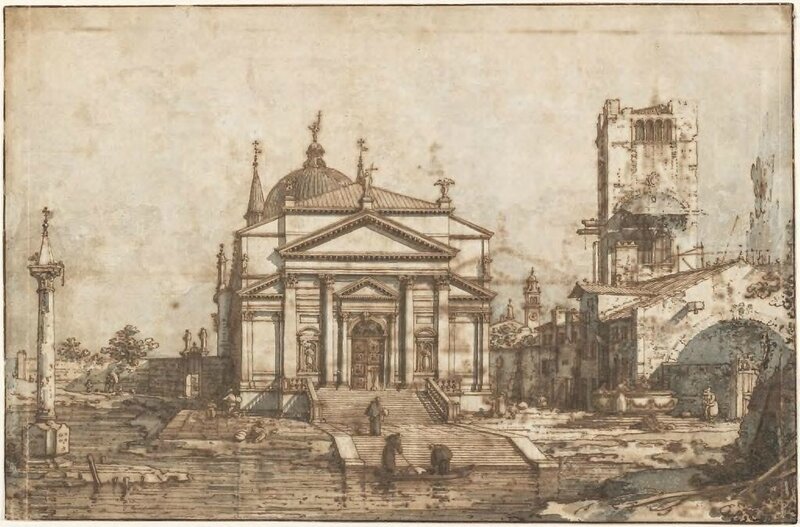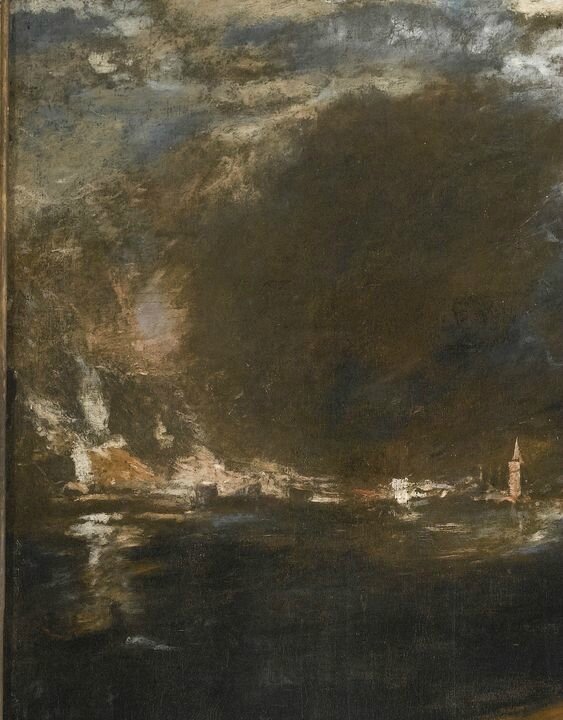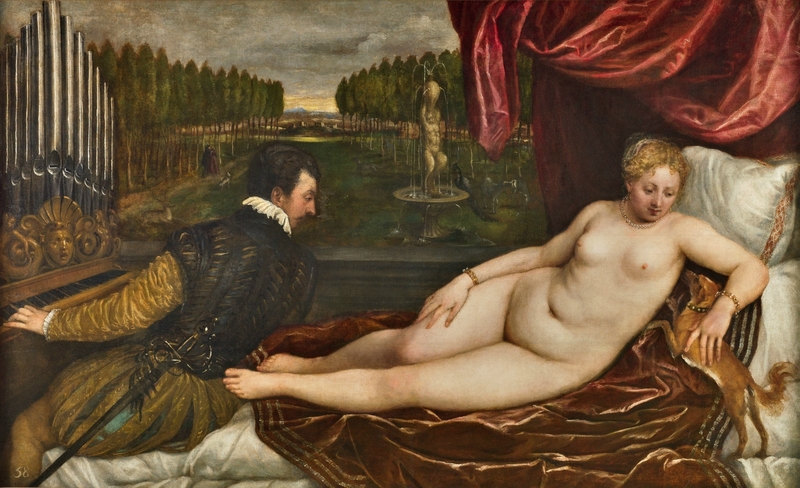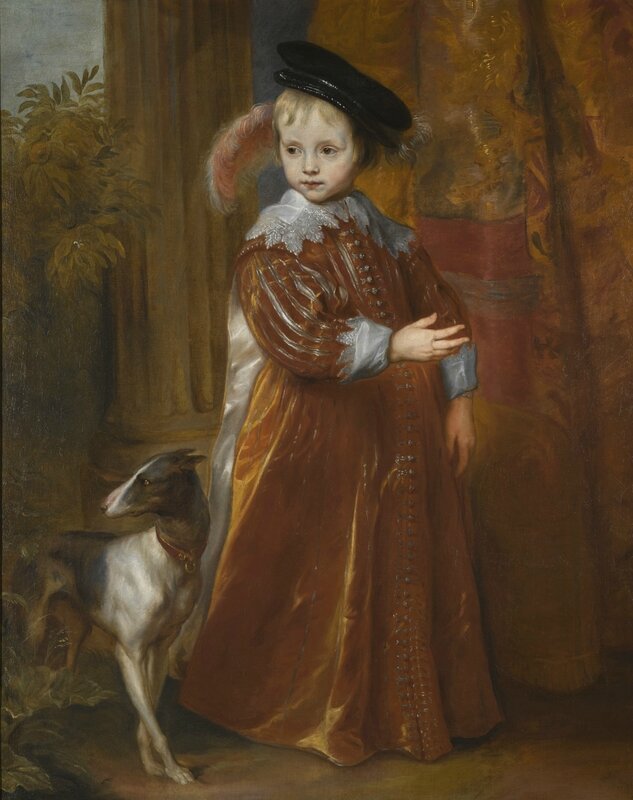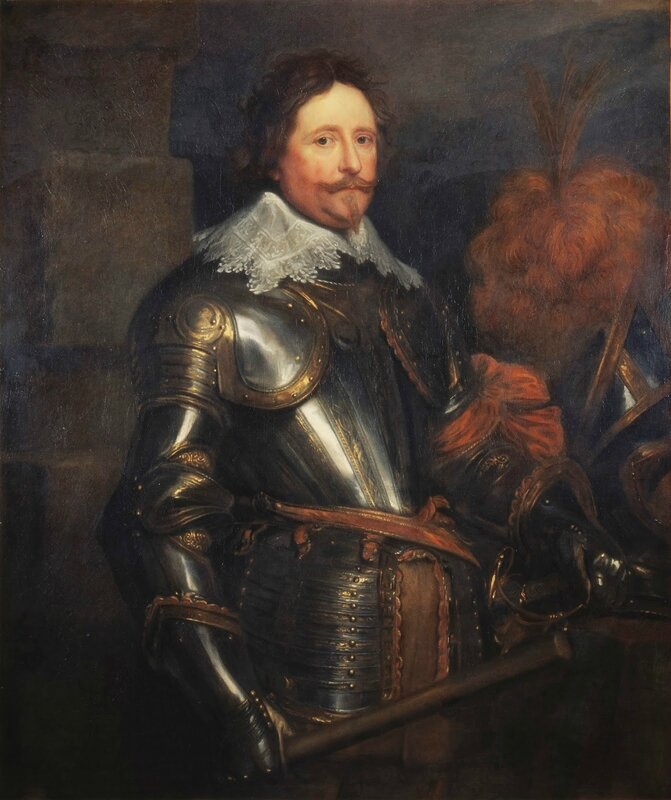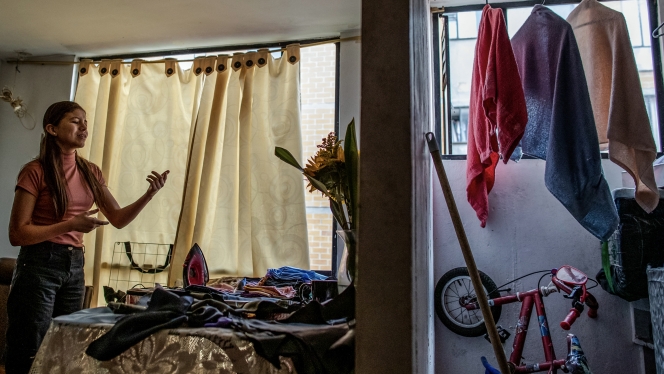NEW YORK, NY.- An exceptional selection of European paintings, spanning from the 14th to the 19th centuries will be offered in Sotheby’s Evening Sale of Master Paintings on 1 February 2018 in New York. Highlighting the annual Masters Week sale series, the Evening Sale exhibition will be on public view in Sotheby’s New York galleries beginning 26 January.
The February sale features a rare and striking portrait of Cristoforo Segni, Maggiordomo to Pope Innocent X, painted and signed by Velazquez and Cremonese painter Pietro Martire Neri Martire (estimate $3/4 million). Painted around 1650, during Velazquez’s second trip to Rome, the work is one of a series of portraits painted for the Court of Pope Innocent X on the occasion of his Jubilee, the most famous being Portrait of Innocent X (1650, Galleria Doria Pamphilij). Having remained hidden in the present collection since the mid-20th century, the painting was recently featured in a dedicated exhibition to Velazquez at the Grand Palais, Paris in 2015. Velazquez’s highly expressive and distinctive brushwork is clearly evident in areas of the canvas, in particular the head of the sitter.
![Diego Rodríguez de Silva y Velázquez and Pietro Martire Neri, Portrait of Monsignor Cristoforo Segni (D]()
![1]()
Lot 48. Diego Rodríguez de Silva y Velázquez (Seville 1599 - 1660 Madrid) and Pietro Martire Neri (Cremona 1601 - 1661), Portrait of Cristoforo Segni, Maggiordomo to Pope Innocent X, inscribed on the letter: Alla Sant.[i]ta di N[ost]ro Sig[no]re / Innocenzio Xo / Monsre Maggiordomo / ne parti a S[ua] S[anti]ta / Per / and signed, or bears signature: Dieg[?]o d. Silva Velasqu[ez] / [and in a different hand:] e Pietro Martire Neri, oil on canvas, 44 7/8 by 36 1/4 in.; 114 x 92 cm. Estimate 3,000,000 — 4,000,000 USD. Photo: Sotheby's.
Provenance: Private collection, Bologna;
Don José de Salamanca y Mayol, Marqués de Salamanca and 1st Conde de Llanos (1811–83);
His sale (Galerie Salamanca), Paris, Hôtel Salamanca, Rue de la Victoire, 50, Pillet, Le Roy and Febvre, 3–6 June 1867, lot 37, unsold at 16,200 Francs (as Velázquez); Salamanca Collection sale, Paris, Hotel Drouot, Pillet and Haro, 25–26 January 1875, lot 35, for 19,300 Francs, to Luisa Gonzalés (as Velázquez);
Luisa Gonzalés (1847–1924), wife of Auguste Dreyfus (1827–97), Hôtel Dreyfus, 3 avenue Ruysdaël, Paris;
His sale, Paris, Galerie Georges Petit, 29 May 1889, lot 115, for 5,600 francs (as Velázquez), where probably unsold;
Thence probably by family descent to Anne de Talleyrand Périgord, Duchess de Premio Real, self-styled Duchess of Dreyfus-Gonzalez (1877-1945), Paris, by 1936;
Probably acquired from the above, or from her heirs, by the father of the present owner in Paris, 1958.
Exhibited: Madrid, Casón del Buen Retiro, Velázquez y lo Velazqueño, 10 December 1960 – 23 February 1961, no. 103 (as Velázquez and Neri);
Paris, Grand Palais, Velázquez, 25 March – 13 July 2015, no. 77.
Literature: A. Palomino, Museo pictórico, 1724, Madrid 1936 ed., p. 167;
C.B. Curtis, Velazquez and Murillo: A Descriptive and Historical Catalogue of the Works of Don Diego de Silva Velazquez and Bartolomé Estéban Murillo, London and New York 1883, no. 156, p. 66 (as Velázquez);
G.C. Cruzada Villaamil, Anales de la vida y de las obras de Diego de Silva y Velázquez, escritos con ayuda de nuevos documentos, Madrid 1885, p. 322, no. 137 (as Velázquez);
C. Justi, Diego de Velazquez und sein Jahrhundert, Bonn 1888, voI I, pp. 192–93, note 1 (as Velázquez and Neri);
A.L. Mayer, Diego Velazquez, Berlin 1924, pp. 147–48 (as Velázquez);
A.L. Mayer, ‘Pietro Martine Negri, ein italienischer Nachahmer des Velazquez’, in Belvedere, September 1928, Vol. XIII, pp. 60–63, reproduced (as Neri perhaps after Velázquez);
H. Voss, ‘Zur Kritik des Velázquez-Werkes’, in Jahrbuch der Preußischen Kunstsammlungen, vol. 53, 1932, pp. 49–51, reproduced on p. 49 fig. 6 (as Velázquez and Neri);
E. Lafuente Ferrari, ‘En torno a Velázquez: un artículo de Hermann Voss’, in Archivo Español de Arte, 22, 1932, pp. 268–70 (as Velázquez and Neri);
A.L. Mayer, Velazquez: A Catalogue Raisonné of the Pictures and Drawings, London 1936, p. 100, no. 426, reproduced plate 141 (as Neri for the greater part; at best begun by Velázquez);
B. de Pantorba, La vida y la obra de Velazquez: Estudio biográfico y crítico, Madrid 1955, pp. 236–37, no. 172, reproduced (as Velázquez and Neri);
H. Voss, ‘Über das bildnis der Maggiordomo Segni von Velázquez’, in Varia velazqueña. Estudios sobre Velazquez y su obra, Madrid 1960, vol. I, pp. 335–38, vol. II, reproduced plates 103–105 (as Velázquez);
J. López-Rey, Velázquez. A Catalogue Raisonné of his Œuvre, London 1963, pp. 283–84, cat. no. 474, reproduced plates 364 and 365 (as by Neri after Velázquez);
A.E. Pérez Sánchez, Pintura italiana del s. XVII en España, Madrid 1965, p. 357 (as Velázquez and Neri);
M. Bardi, L’opera completa di Velázquez, Milan 1969, pp. 110–11, no. 140 (as attributed to Velázquez);
J. López-Rey, Velazquez. The Artist as a Maker, Lausanne and Paris 1979, pp. 113–14, reproduced plate 39 (as Neri, presumably after a lost sketch by Velázquez);
E. Harris, Velazquez, Oxford 1982, pp. 151–52, reproduced p. 152, plate 155 (as copy by Neri of a lost original by Velázquez);
R. Barbiellini Amidei, ‘L’iconografia pamphiliana. Notizie dei ritratti di Papa Innocenzo X’, in S. Alloisi ed., Imago Pietatis 1650. I Pamphilj a San Martino al Cimino, exhibition catalogue, Rome 1987, p. 100 (as Neri after a lost sketch by Velázquez);
D. Ortiz, A. E. Pérez Sánchez, J. Gallego (eds), Velázquez, exhibition catalogue, New York 1989, p. 236 (as a disputed work by Velázquez);
O. Melasecchi, ‘Pietro Martire Neri ritrattista cremonese nella Roma di Innocenzo X’, in Innocenzo X Pamphilj: Arte e potere a Roma nell’età barocca, A. Zuccari and S. Macioce (ed.), Rome 1990, pp. 184–85, reproduced on pp. 183–84, figs 6–7 (as begun by Velázquez and completed by Neri);
J. López-Rey, Velázquez. Painter of Painters, 2 vols, Cologne 1996, vol. I, p. 176 (as Neri, presumably after a sketch by the Master that has not been preserved);
S. Salort Pons, Velázquez en Italia, Madrid 2002, p. 233, pp. 370–73, no. 24, reproduced in colour on p. 233, plate 197, and on p. 371 (as Neri and Velázquez?);
F. Petrucci, Pittura di Ritratto a Roma. Il Seicento, Rome 2007, vol. III, reproduced p. 700, fig. 558 (as Neri);
J.M. Cruz Valdovinos, Velázquez: vida y obra de un pintor cortesano, Zaragoza 2011, p. 291, reproduced on p. 292 (as Neri);
M. Tanzi, Pietro Martire Neri: Celebratory Portrait of Ancislao Gambara, Paris 2011, p. 9, p. 11, reproduced fig. 4 (as Neri [and Velázquez?]);
V. Damian, in La Vierge enfant de Francisco de Zurbarán, Trois portraits par Simon Vouet, Pietro Martire Neri et Angelika Kauffmann, Tableaux Bolonais, Vénitiens et Napolitains du XVIe et XVIIe siècle, exh. cat., Galerie Canesso, Paris 2014, pp. 50–51, reproduced on p. 50, fig. 1 (as Pietro Martire Neri [and Diego Velázquez?]);
G. Kientz, Velázquez, L’affrontement de la peinture, Paris 2015, pp. 262–77 and p. 365 (as Velázquez and Neri);
G. Kientz in Velázquez, exhibition catalogue, Grand Palais, Paris, 2015, p. 26, p. 258, pp. 264–66, p. 344, no. 77, reproduced on p. 265 (as Velázquez and Neri).
Note: This striking portrait of Cristoforo Segni, Maggiordomo to Pope Innocent X from 1645 to 1653, was painted by Velázquez during the artist’s second trip to Rome, around 1650. Parts of the painting were executed by the Cremonese painter Pietro Martire Neri, who according to Antonio Palomino worked alongside Velázquez during his second sojourn in the Eternal City. The painting has only recently emerged from obscurity, for inclusion in the recent exhibition dedicated to Velázquez at the Grand Palais, Paris, having remained hidden in the present collection since the mid-twentieth century. During the second half of the nineteenth century it formed part of the illustrious collections assembled by the Marqués de Salamanca in Madrid, who owned several works by the great Sevillian master and whose collection was dispersed at auctions in Paris during the 1860s and 1870s.
In his celebrated Museo Optico of 1725 the biographer and painter Palomino recorded that Velázquez painted the Majordomo to Pope Innocent X, and it was Cruzada Villaamil in 1885 who first established the clear link between Palomino’s reference and the present work. As Maggiordomo to His Holiness Pope Innocent X, Cristoforo Segni was a high-ranking member of the clergy appointed by the Pope to oversee the apostolic palaces. Segni was one of the first members of the Pope’s entourage with whom Velázquez came into contact, for as recorded by Palomino, the artist stayed at Segni’s family house in Bologna in 1649 during his journey to Rome. Segni was also a patron of the sculptor Alessandro Algardi, from whom Velázquez had commissioned works on behalf of Philip IV, and as such the two had various matters in common.
Velázquez had come to Rome in May 1649, bearing paintings as gifts for Innocent X on the occasion of his Jubilee, which began on the 25 December 1649.1 This was his second visit to Italy, following an earlier trip in 1629-31. He reached Rome via Genoa, Milan, Venice and Florence, but once in the Eternal City his stay was interrupted only by visits to Naples and Gaeta in June-July 1649 and again in March 1650. He did not leave again for Madrid until 1651, but his work in Rome in that year was probably confined only to official business. There is no doubt that this short period represents the first unquestioned highpoint of his art, when his creativity and sheer technical virtuosity reached new peaks. The exact chronology of Velázquez’s Roman portraits is not known for certain, but they were presumably all painted in a very short period between his arrival in May 1649 and November 1650. If we are to believe his biographer Palomino, his first work was a portrait of his mulatto servant Juan de Pareja (New York, Metropolitan Museum, fig. 1). Perhaps, as Palomino suggests, this was intended as an exercise in portraiture from the life in a city where his work was almost unknown.2 In any event this magnificent likeness, with its astonishing intensity of expression and bravura yet restrained technique caused universal admiration when exhibited at the Pantheon in 1650. Whether from the success of this work or more likely from the access Velázquez had to the Papal court as a result of his position as painter to the King of Spain, it was soon followed by his portrait of Pope Innocent X himself (Rome, Galleria Doria Pamphilij, fig. 2). This was presumably Velázquez’s first ‘official’ commission in Rome, and may have been commissioned by the King himself. This exceptional masterpiece won universal admiration – even the Pontiff himself admitted that the piercing likeness was almost “too truthful”. Sir Joshua Reynolds writing over a century later would describe it as “one of the first portraits in the world” and its position as one of the greatest evocations of position and personality ever achieved remains as true to this day as it was then. Although its design was firmly in a tradition going back through Titian to Raphael, in particular the former’s Portrait of Pope Paul III of 1543 (Naples, Gallerie Nazionale, Capodimonte), its strength and immediacy is won by its remarkable chromatic brilliance, achieved by a subtle range of harmonised crimsons and reds, offset by a brilliant creamy white. Both portraits are said to have been mistaken in real life for their sitters, but while this is no doubt apocryphal, they clearly impressed his contemporaries sufficiently to win Velázquez admission both to the Accademia di San Lucca in January 1650 and subsequently the Congregazione dei Virtuosi in the Pantheon. To this day they remain without doubt among his very greatest works. If one were to add to them the celebrated Toilet of Venus (London, National Gallery, fig. 3), better known as the ‘Rokeby’ Venus after a later owner, which some critics also believe to have been painted while Velázquez was in Rome rather than just prior to his stay there, then it would be quite reasonable to claim these as the most remarkable and important years of the painter’s career.3 As it was, Velázquez had few if any rivals as a court portraitist in Rome at the time of the Papal jubilee. His greatest contemporaries in terms of portraiture were both sculptors – Gianlorenzo Bernini and Alessandro Algardi – and within a short while he enjoyed enormous respect and prestige and his assimilation into the artistic life of the city Rome was complete.
![4]()
fig. 1. Velázquez, Portrait of Juan de Pareja, 1649, New York, Metropolitan Museum of Art.
![5]()
fig. 2. Velázquez, Portrait of Pope Innocent X, 1960, Rome, Galleria Doria Pamphilij.
![6]()
fig. 3. Velázquez, Toilet of Venus, London, National Gallery.
From a slightly elevated viewpoint, Brueghel opens a window onto early seventeenth century Flemish life, particularly the daily life of a village settled on the edge of a river on a clear, crisp, summer’s day. The left half of the composition is dominated by an expansive waterway that pulls the eye into the depths of the landscape, from the jetty in the foreground, along the tree lined shore, to the faint outlines of ships on the distant horizon. Here, the water seamlessly blends into a light blue sky with feathered white clouds and a golden yellow sun. On the right half, balancing out the seemingly mirrored tranquility of the river and sky, is a bustling shoreline and landing site filled with colorful figures, animals, and remarkably drawn boats. Beyond and through the trees at right appears a quiet village with houses, wooden sheds, horse drawn carts, and, in the distance, the steeple of a church.
What adds another degree of grandeur to this multi-figure composition is the attention with which Brueghel has observed and captured not only the natural world around him, but also the minutia of the everyday. A few ducks with orange bills paddle around the shallow waters of the near foreground, their movement forming faint puddles around them. Two children in the boat nearby lean over the edge to observe a woman dipping a white cloth into the cool water. A gentleman in the same boat uses a steering pole to steady a another vessel in the shallows while a mother passes her child to another woman on board the already rather full boat. Two farmers relax with a basket of produce in the shade at right, as additional onlookers of various ages gather on shore beneath a line of lush trees awaiting the next vessel to carry them down the river. Saddled horses appear in two of the other boats, suggesting that the desired destination on the river is perhaps a kermesseor a festive gathering, to and from which the villagers may be traveling.
Towards the end of the sixteenth century Brueghel began to explore the theme of vast open seascapes near a shoreline as exemplified in a small oil on copper dated to circa 1592 in a private collection.1 By the first decade of the next century, however, he turned towards the more intimate river landscapes that employed an orthogonal body of water to order the rural scene by pulling the viewer’s eye to a vanishing point in the distance. This technique was first introduced by Pieter Bruegel the Elder, Jan’s father, in his famous river landscape drawing of about 1556 now in the Kupferstichkabinett, Berlin.2 Jan’s familiarity with his father’s drawing, as well as this compositional device, is recorded both in a copy he made after his father’s work as well as in a comparable drawing of about 1600 in the Musée du Louvre, Paris.3 What is revolutionary about the present composition, however, is the way that Brueghel uses not only the river orthogonal but also introduces the steep diagonal of the shoreline to create a more realistic sense of space and depth that runs from right to left
The river landscape subject proved popular among Jan Brueghel’s clientele on copper and panel, particularly during the second decade of the seventeenth century. Unlike his brother Pieter Brueghel the Younger who responded to the popular demand by producing copies of his own works, Jan Brueghel the Elder approached each river landscape independently, always making variations to his compositions so that rarely any two were exactly alike. An early forerunner to the present painting is found in a copper datable to around 1604 in the Musée des Beaux-Arts, Nantes (fig. 1).4 While the two are related in terms of composition, the present painting, completed over a decade after, is more sophisticated in handling, particularly in the rendering of depth within the picture plane as there is a seamless transition foreground, to middleground, to background.
![Scène fluviale ou Le Débarquement]()
fig. 1. Jan Brueghel the Elder (1568-1625), The Embarkation, oil on canvas, Musée des Beaux-Arts, Nantes, France/ Bridgeman Images
This painting is first recorded in the English royal collection. It belonged to King Charles I (1600–1649) and was displayed alongside the King's most highly prized Titians at Whitehall. It is listed there in the inventory of 1639 drawn up by Abraham van der Doort, as hanging in the First Privy Lodging Room: ‘Done by Tichian/ Item the Picture of St Margarett with a little reed cross in her left hand triumphing over the Divell Being in a dragons Shape an intire figure Soe bigg as ye life In a wodden guilded frame’. The Saint Margaret hung in the principal room of Titians, with the early Pesaro presented to Peter(Koninklijk Museum voor Schone Kunsten, Antwerp) and other remarkable works such as Venus with an Organist (fig. 1) and The Allocution of the Marquis del Vasto to his Troops (both Prado, Madrid); The Entombment of Christ, The Supper at Emmaus and the 'Allegory of Alfonso d'Avalos' (all three now at the Musée du Louvre, Paris); and Woman in a Fur(Kunsthistorisches Museum, Vienna).2
![prado]()
fig. 1. Titian, Venus and Music, circa 1550, oil on canvas, 138 by 222.4 cm. Museo del Prado.
Soon after the King's execution, the decision was taken by Parliament to sell off his collections. Full inventories were drawn up and valuations given with a view to the money raised from their sale paying off the King's debts. The King's creditors were entitled to acquire pictures; others were paid in goods from Charles's estate. In the case of the Saint Margaret it was sold to John Embry, a royal plumber, whose name appears on the First List of the late King's servants and creditors comprising those most in need. Francis Haskell in his essay on Charles I's collection cites Embry's case as a representative example of a member of the King's retinue who had remained unpaid. The present work, which is listed in an inventory of pictures drawn up in September 1649, was valued at £100. As Haskell describes, Embry was owed £903 and was recompensed only partly in cash. To cover the remaining sum he was allowed to choose pictures to make up the value – among them the present painting of Saint Margaret.3 According to Nuttall, of the twenty-four pictures given to him as settlement of the debt, the Saint Margaret was the most important. Presumably Embry's objective was then to sell it as quickly as possible and convert it into cash. During the Commonwealth Embry became Oliver Cromwell's Surveyor-General of Works and subsequently, at the Restoration, found himself obliged to defend his position, returning a portion of the pictures to Charles II.4 The picture is next recorded in Hampshire, in the collection of Richard Norton (d. 1732), though it is not known how he acquired it. He may have inherited it from his grandfather Colonel Norton (d. 1692). The Saint Margaretthen entered a British aristocratic collection where it remained until the mid-twentieth century.
The Saint Margaret is likely to have been begun at the same time as the Prado painting, which is generally recognised as the prime version of the composition and dated to the mid-1560s. Indeed it seems probable that the present work was painted alongside the version now in the Prado, with Titian utilising his workshop to block in areas of the painting but finishing the key areas of the painting himself. The expressive power of Titian’s later style is nowhere more clearly demonstrated than in the lyrical and atmospheric depiction of the city of Venice on fire in the background. On the skyline the campanile of St Mark glows in fiery orange and pinks, whilst the stormy waves of the sea are animated by dark blue and green brushstrokes. In the sky billowing smoke rises upwards to intermingle with the clouds in a passage of painting that presages that of the Impressionists, more than three centuries later.
The x-radiograph reveals much more vigorous application of paint in places that now appear rather dark and flat, including the area to the left of the head now covered with brown paint, and changes to the structure of the dragon, as well as modifications to the city skyline. A photograph of the painting taken at the time of the Harcourt sale in 1948 shows the larger extent of the canvas at the top edge of the composition before it was reduced, at some point before 1958. The composition was then more closely comparable to that of the Prado version.
As is characteristic with Titian’s late works, the darker tones, fiery landscape and summary handling of the paint in the present work create a sense of drama that is entirely fitting to the narrative. Margaret of Antioch was a legendry virgin martyr. She refused a proposal of marriage from the prefect of Antioch and was cruelly tortured and imprisoned as a result. Satan allegedly appeared to her in the form of a dragon and devoured her. The cross she held in her hand irritated the monster’s insides and the dragon burst open allowing her to escape unharmed, only to be subsequently decapitated. Panofsky notes that Titian’s decision to depict Saint Margaret and the dragon in an outdoor setting suggests he was using an apocryphal version of the legend.5
Titian’s Saint Margaret is conceived with a profound understanding of the dramatic potential of the scene. She is a triumphant figure whose body, depicted in dramatic contrapposto, fills the entire right-hand side of picture plane, almost touching the right-hand and lower margins. Prof. Paul Joannides has noted Titian's deliberate comparison with Raphael and Giulio Romano's versions of the same subject (Giulio's Saint Margaret was in Venice in the early sixteenth-century, in the collection of Zuananonio Venier, today housed in the Kunsthistorisches Museum, Vienna). Titian's Margaret surpasses the serenity of Giulio's interpretation, which lacks the intensity of expression and setting. Titian's saint is painted in a myriad of colours and her luminous light green tunic with its bright white sleeves and rose pink veil stands out from the more earthy, brown based tones of the rest of the canvas. The dragon that occupies the bottom resister of the canvas is predominantly painted in brown and blackish hues and the only flashes of colour are the strokes of red and white delineating his vicious mouth. The implied movement in Saint Margaret’s twisting body contrasts to the stolidity of the rock face behind her and she emerges from the picture plane as an impressive figure, trampling the dragon underfoot and holding her cross aloft.
The painting was inspected on 28 September 2012 by Prof. Peter Humfrey and Dr Nicholas Penny. Both believe it to have been painted as a second version of the Prado picture and with a significant degree of studio assistance. Prof. Humfrey saw the painting again in person on 27 October 2017. In his opinion the Saint Margaret is a picture produced under Titian’s direction in his workshop, with the execution largely due to the workshop but parts, such as the landscape in the background, possibly involving the direct involvement of Titian himself. Prof. Joannides inspected the painting on 26 October 2017; he maintains his view, published in 2004, that it is by Titian and his studio. The Royal Collection is currently working on an online reconstruction of the collection of Charles I at Whitehall Palace, which will include the present work. We are grateful to all those cited for their comments. In particular we wish to thank Lucy Whitaker and Niko Munz at the Royal Collection for their help in compiling this catalogue entry.
1. P00455. See H.E. Wethey, The Paintings of Titian, London 1969, vol. I, cat no. 117, pp. 141–42. One other treatment of the subject is recorded, now in the Escorial, a painting sent to Philip in October 1552, today is in very poor condition, making it difficult to determine the extent of the workshop's participation (210 x 170 cm.; Humfrey 2007, no. 187).
2. See Millar 1958–60, pp. 14–16.
3. See Nuttall 1965, p. 303 and ff. In the record of the sale the pictures acquired in this way are shown as having been 'sold'.
4. Six pictures according to Nuttall; 9 according to Brotton; see Brotton 2006, p. 319. Brotton states that Titian's Saint Margaret had been sold to Don Alonso de Cárdenas, Spanish Ambassador to Philip IV. However the picture is not listed in 'A Record of the Paintings at Somerset House, which belonged to the King and Queen, that were sold to the Lord Ambassador of Spain', see A.J. Loomie, 'New Light on the Spanish Ambassador's Purchases from Charles I's Collection 1649-53', Journal of the Warburg and Courtauld Institutes, vol. 52, 1989, pp. 257-67.
5. E. Panofsky, Problems in Titian: Mostly Iconographic, London 1969, pp. 34–35. Indeed, Dr. Michel Weemans, curator of Une image peut en cacher une autre, Paris, Grand Palais, 2009, has speculated (private communication to the owner) that the presence of anthropomorphic shapes in the form of dragons’ heads that he detects in the rocks surrounding the saint may allude to the legend of the Lernaean Hydra – the saint having overcome the dragon only to be faced with a proliferation of new threats around her. If so, this would suggest an additional level of involvement in the design of this version on the part of the artist.
Although they make up only a fraction of his considerable and varied artistic output, Sir Anthony van Dyck’s depictions of children are among the most memorable and enchanting works that the artist produced. Portrait of Prince Willem II of Orange as a Young Boy, with a Dog perfectly exemplifies this subject, portraying the innocence of the five-year-old Prince, without sacrificing his nobility (estimate $2/3 million). Two versions of this charming painting by van Dyck are recorded in period sources - one painted for the parents of Prince Willem II, and another version made for King Charles I of England. Recent cleaning of the present work and its subsequent public exhibition at the Rubenshuis Museum in Antwerp has led scholars to believe that this painting is almost certainly the recorded version painted for King Charles I.
![Sir Anthony van Dyck, Portrait of Prince Willem II of Orange as a Young Boy, With A Dog]()
Lot 42. Sir Anthony van Dyck (Antwerpt 1599 - 1641 London), Portrait of Prince Willem II of Orange as a Young Boy, With A Dog. Oil on canvas, 50 1/2 by 39 1/2 in.; 128.3 by 100.4 cm. Estimate 2,000,000 — 3,000,000 USD. Photo: Sotheby's.
Provenance: Almost certainly King Charles I of England, by August 1632 (see note below), and included in the sale of the "Late King’s Goods", 1st March 1652/3, No. 278, ‘A Dutch Prince at length, wth a dog’, where acquired by Edward Bass and John Hunt;
Michael Humble, Esq., of Gwersyllt Park, Denbighshire (according to a label on the reverse, see note below);
Bartlett Joshua Palmer, Davenport, Iowa (inscription on the reverse);
Anonymous Sale, Christies New York, 26th January 2011, lot 19, (as Studio of Sir Anthony van Dyck), where acquired by the present owner for his personal collection.
Exhibited: Antwerp, Rubenshuis Museum, 2012-2016.
Literature: Rubenshuis Guide, no.41 (as the version painted by van Dyck for King Charles I);
See also under Barnes, de Poorter, Miller & Vey, ‘Van Dyck: A Complete Catalogue of the Paintings’, New Haven, 2004, Cat. III. 114, p. 339-40, where Horst Vey notes a lost version of the composition, painted by van Dyck for King Charles I.
Note: Two versions of this charming painting by van Dyck are recorded in period sources, one painted for the parents of Prince Willem II, and another version made for King Charles I of England. The portrait painted for the sitter’s parent descended in the family and is today in the Schloss Mosigkau museum (fig. 1). This fascinating painting’s recent reappearance, followed by a careful cleaning and subsequent public exhibition at the Rubenshuis Museum in Antwerp, has afforded scholars the opportunity to reassess it, confirming its status as an important work by the master, which in all likelihood is the hitherto lost painting documented as made by van Dyck for King Charles I of England.
![Sir Anthony van Dyck, Portrait of Prince Willem II of Orange, Schloss Mosigkau, Dessau, Germany]()
fig. 1. Sir Anthony van Dyck, Portrait of Prince Willem II of Orange, Schloss Mosigkau, Dessau, Germany.
Although they make up only a fraction of his considerable and varied artistic output, van Dyck’s depictions of children are among the most memorable and enchanting works that the artist ever produced. This delightful portrait of Prince Willem II of Orange exemplifies the genre. It depicts the young Prince at about 5½ years wearing a long gown of golden orange silk (the color of his princely house) with slashed sleeves, decorated with lace collar and cuffs. He wears a plumed cap of black velvet and stands in a relaxed and elegant pose, gazing to his right as does his dog, as if someone is drawing their attention. Van Dyck deftly indicates the young Prince’s lineage with a symbolic orange tree at the left, while behind hangs a rich tapestry arras, rendered in flickering brushstrokes, and embroidered with the arms and lion of the House of Nassau.
In the winter of 1631/32, van Dyck set north from Antwerp to the court of The Hague, having been summoned by Frederick Hendrick, Prince of Orange, an invitation that only served to boost his already considerable reputation. He arrived before 28th January 1632, when no less a personage than Constantijn Huygens noted that he had just that day been sitting to the painter.1 In addition to the Dutch prince’s patronage, van Dyck no doubt hoped to broaden his prospects, not only by leaving the confines and limitations of his native city, but also with an eye to a move across the Channel to the English court. King Charles I’s agent Balthasar Gerbier had been assiduously wooing the painter for some time, attempting to secure his services, and while a final decision had not been made, one was imminent. In addition, Prince Frederick Hendrik and his wife Amalia van Solms hosted Elizabeth Stuart, the deposed Queen of Bohemia, who was Charles I’s sister. Thus, van Dyck’s arrival appears to be a canny decision, not only for the commissions it afforded, but as a way to ingratiate himself further with the Stuart dynasty. Van Dyck would, in fact, arrive in England just a short time afterwards, in April 1632 where, save for occasional sojourns, he would remain for the rest of his life in the service of the King.
While in The Hague, van Dyck painted portraits of the ruling family, Frederick Hendrik, Prince of Orange (fig. 2, Baltimore Museum of Art, inv. 1938.217) and Amalia van Solms (fig. 3, Tokyo Fuji Museum, Tokyo, Japan), as well as their eldest son and heir, Willem II ( fig. 1, Schloss Mosigkau, near Dessau, Germany).2 Perhaps unfettered by the courtly expectations required of an image for a sitting monarch, the painting of Willem II is both formal and informal at the same time, and shows van Dyck’s extraordinary abilities to their most potent effect. Van Dyck captures perfectly the innocence of a young boy, but sacrifices nothing of his nobility in doing do. Drawing on the influence of Titian, notably his portrait of Clarice Strozzi(fig. 4, Gemäldegalerie, Berlin), van Dyck developed a pictorial language for the depiction of young nobles which was to influence artists such as Gainsborough, Reynolds and Sargent in the centuries to come.
![Sir Anthony van Dyck, Flemish (1599-1641), Frederick Henry, Prince of Orange, 1628]()
fig. 2. Sir Anthony van Dyck, Flemish (1599-1641), Frederick Henry, Prince of Orange, 1628. 45 x 38 in. (114.3 x 96.5 cm., oil on canvas. Credit Line: The Mary Frick Jacobs Collection.
![Anthony van Dyck (1599-1641), Portrait of Amalia von Solms-Braunfels (1602-75) 1629]()
fig. 3. Anthony van Dyck (1599-1641), Portrait of Amalia von Solms-Braunfels (1602-75) 1629, oil on canvas, 114.3 x 95.9 cm. © Tokyo Fuji Art Museum
![Titian (Tiziano Vecellio) (c]()
fig. 4. Titian (Tiziano Vecellio) (c. 1488-1576), Portrait of Clarissa Strozzi at the Age of Two, 1542, oil on canvas, 115 x 98 cm. Inv. 160A. Photo: Joerg P. Anders. Gemaeldegalerie, Photo Credit:bpk Bildagentur / Art Resource, NY.
In addition to the aforementioned set ordered by Prince Frederik, van Dyck was commissioned by King Charles I, whose eldest daughter Mary was to marry Willem nine years later, to complete a further set:
Sir Anthony vandike hath by o’ Command made and presented us wth divers pictures…of the Prince of Orange…another of the princesse of Orange wth another of their sonne at half length at Twenty pounds appeece.
Payment for these were authorized in a Royal Warrant dated 8th August 1632. The reference to ‘half length’ portraits was evidently shorthand for the whole group, two of which were true half lengths – an inference confirmed by the reference at the sale of King Charles I’s collection in 1652 (No. 278), where it was described as ‘A Dutch Prince at length wth a dog’.
A full length studio or later copy of the composition is preserved at Petworth, where the dog appears to adhere to the type in the present example, rather than the Mosigkau picture. The breed of the dog, which appears to be a whippet cross, is more robust and muscular in the present painting, and also has a more pronounced snout, thus suggesting that it was the prototype brought to England and furnished the template for the Petworth copy.3 No other autograph version of this composition is recorded.
The present Portrait of Willem II of Orange is thus almost certainly the recorded version painted for King Charles I. The relationship between the Mosigkau version and the present canvas is particularly fascinating and informative. The condition of the Dessau picture has been somewhat compromised in the past, but it is clear that the painting does have similar handling of paint to the present work. Perhaps the most striking difference between the two versions is in the quality and characterization of the dog, which is finer and anatomically more sophisticated in the present painting. Pentiments also exist in the present composition. Some, such as that along the contour of the Prince’s collar in front of the tapestry, as well as subtle shifts in the hands, and around the dog’s head and legs are visible to the naked eye, while infra-red technology further reveals the freedom and spontaneity with which it was painted. While it is perhaps pointless to discuss primacy in the case of two pictures which would have been produced either simultaneously or nearly so, these details would suggest that the present composition may indeed be the first version. In light of the importance of King Charles I to van Dyck from 1632 onwards, and his reputation as a connoisseur, this would not be surprising.
Note on the Provenance:
The portraits of the Orange family painted for Charles I remained in the Royal Collection until after the execution of Charles when the collection was sold by the Commonwealth in one of the most famous art dispersals in history. On 1st March, 1652, as lot 278, ‘A Dutch Prince at length, with a dog,’ presumably the present painting, was sold to Edward Bass and John Hunt, both creditors of the late king.
Edward Bass was a royal official under Charles I who, together with John Hunt was one of a handful of insiders who purchased a large quantity of the late King’s goods, and were amongst the chief beneficiaries of the sale. Bass headed no fewer than three of the fourteen ‘dividends’ (syndicates created by the King’s creditors, formed for the purpose of taking goods in lieu of payment), while Hunt (a former linen draper to Queen Henrietta Maria) was one of the sale’s treasurers. In addition to van Dyck’s portrait of Prince Willem II, Edward Bass also owned the jewel of the Royal Collection - Raphael’s Holy Family, ‘La Perla,’ now at the Museo del Prado. Bass was one of the ‘undoubted winners in the sale’ who formed part of the group of ‘cosmopolitan artists, dealers and merchants’ who were ‘the real specialists in money and art, and employed by all sides – crown, republic, dividends and foreign embassies’ (see J. Brotton, The Sale of the Late King’s Goods, 2006, pp. 258, 266, 283, 308-9).
As with so many paintings from the Royal Collection, the Portrait of Willem II as well as those of his parents were subsequently dispersed, and remained untraced for many years.4 A label on the reverse of the present painting is inscribed with the name of Michael Humble, possibly Michael Humble of Gwersyllt Park, Denbighshire Wales. The reverse of the stretcher is also inscribed with the name B.J. Palmer. Bartlett Joshua Palmer (1882–1961), of Davenport, Iowa, was one of the founders of modern chiropractic practice. He amassed a large collection of art and Asian antiquities, which was on view at his clinic at Davenport.
We are grateful to Dr Malcolm Rogers, Professor Christopher Brown and Dr Susan Barnes for each independently confirming the attribution of the present painting to Sir Anthony van Dyck based on their first hand inspection.
1. It must have been a stormy day, as Huygens noted ‘Pingor a Van Dyckio, cum arbor in aedes lapsus esset [I am being painted by van Dyck when a tree fell against the house]’. That portrait, sadly, is lost.
2. Schloss Mosigkau was built for Anna Wilhelmina von Anhalt-Dessau who at her death in 1780 bequeathed the building and its contents to form a monastery for well born aristocratic girls, a foundation which remained until 1945, becoming a museum in 1951.
3. Other copies of varying quality and age are at Welbeck Abbey and Warwick Castle, as well as museums in Prague and Riga, and at the Hallwylska Museet, Stockholm, none of which are of autograph quality.
4. For the portraits of Frederick Hendrik and Amalia van Solms painted by van Dyck for Charles I, see Barnes et al (ibid), p.338-9, under cat III. 112 & 113, where the versions preserved in the Prado, Madrid, are each noted as “probably the version bought by Charles I in 1632”. While many paintings in the Royal Collection bore an identifying brand on the back of the canvas, Sir Oliver Millar’s discussion of this practice in his introduction to ‘Abraham Van der Doort's catalogue of the collections of Charles I’ (Walpole Society, XLIII, 1960) makes it clear that many were not so marked.
The sale also offers an outstanding group of works from the renowned collection of J.E. Safra. In addition to important paintings by Jan Wijnants, Joseph-Marie Vien and Vanvitelli, the collection is led by a pair of still-life paintings from the pioneering female painter Fede Galizia (estimate $2/3 million). Celebrated for her still-life painting in Italy and throughout Europe in the first quarter of the 17th century – particularly ones depicting fruit – the present pair is a testament to the artist’s sensitive approach to subject matter and acute eye for detail.




